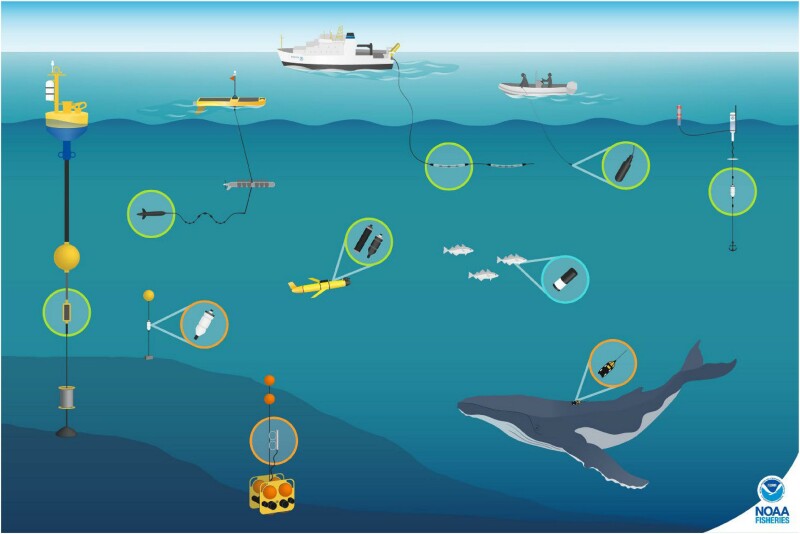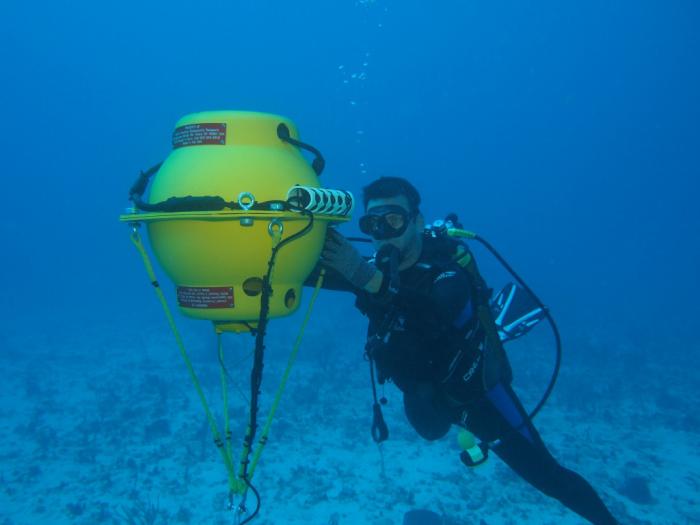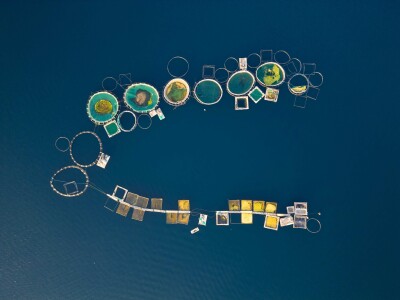Federal agencies involved in planning offshore wind energy development issued a framework for designing and conducting acoustic monitoring of endangered whales and other sea life affected by building and operating wind turbine arrays.
“With a diverse suite of endangered large whale species and a multitude of other protected marine species frequenting these same waters, understanding the potential consequences of construction and operation activities is essential to advancing responsible offshore wind development,” states the paper published Oct. 27 in the journal Frontiers in Marine Science, by a team led by experts with the Bureau of Ocean Energy Management – the lead federal agency for offshore wind development – and National Marine Fisheries Service, which works with BOEM for protecting marine resources.
Underwater microphones can now operate remotely, over long times and at distance, running non-stop to record and archive sounds of the ocean environment.
Advances in using autonomous unmanned vessels, such as submersible electric gliders and saildrones, mean researchers can set microphones on voyages across study areas, along with acoustic receivers deployed on buoys or anchored to the sea floor.
“Passive acoustic monitoring (PAM) represents a newer technology that has become one of several methods of choice for monitoring trends in the presence of species, the soundscape, mitigating risk, and evaluating potential behavioral and distributional changes resulting from offshore wind activities,” the authors wrote.
BOEM may require passive acoustic monitoring as a requirement for wind project permits and approvals. The recommendations are aimed at supporting that need, and set out “minimum procedures, system requirements, and other important components for inclusion, while promoting consistency across plans,” according to the introduction.

The top questions according to the paper: “Does wind energy activity within and across multiple lease areas affect marine animal distribution, behavior, and communication space, and how can we reduce vessel strike risk and prevent exposure of marine animals to loud sounds during construction activities in the wind energy lease areas?”
Passive acoustic monitoring can be used to identify and follow movements of animal populations through wind project areas – making it a particularly useful tool for projecting potential effects on the critically endangered northern right whales that feed and migrate around Atlantic wind areas.
“Monitoring systems can also be used to make real-time decisions like delaying construction, or warning vessels to reduce their speed to protect nearby endangered whales and other animals,” according to a summary from NMFS.
“Passive acoustic monitoring has become an effective and extensively used tool for evaluating the effects of human activities in marine environments,” said Sofie Van Parijs, passive acoustic program lead at the Northeast Fisheries Science Center and lead author of the paper. “As wind energy development expands in U.S. waters, this publication aims to address the need for recommendations and best practices to help industry develop robust and consistent passive acoustic mitigation plans and long-term baseline monitoring programs.”
The framework document addresses national needs and includes supplements “tailored to understanding and minimizing the impacts of offshore wind development on endangered whales and other marine mammals along the East Coast,” according to NMFS.
One is a proposed passive acoustic regional monitoring plan that can guide collecting systematic baseline data, and determine whether there are large-scale, long-term shifts in whale movements and behavior – “either from human activities like offshore wind development or a changing climate,” according to the agency.
A second supplement outlines how wind developers should design passive acoustic monitoring plans to detect animals during turbine construction and reduce any danger to them – include the risk of vessel strikes.
The document also provides templates for standardized data sheets for submitting acoustic detection data, supporting metadata, and GPS location data. Wind developers will be “required to submit these data sheets for each marine mammal detection,” according to NMFS.







